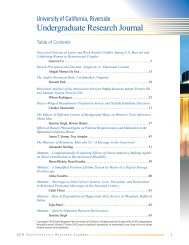2010 - Undergraduate Research, Scholarship and Creative Activity
2010 - Undergraduate Research, Scholarship and Creative Activity
2010 - Undergraduate Research, Scholarship and Creative Activity
You also want an ePaper? Increase the reach of your titles
YUMPU automatically turns print PDFs into web optimized ePapers that Google loves.
Conscientiousness <strong>and</strong> College Class-Level<br />
Differences<br />
Alan F. Carrizo, Psychology<br />
Mentors: Angela Minh-Tu Nguyen<br />
Verónica Benet-Martinez<br />
Department of Psychology<br />
The conscientiousness personality trait can be<br />
defined as being responsible, deliberate, <strong>and</strong><br />
organized. Many of the characteristics that shape<br />
a conscientious person are, in most cases,<br />
needed for college success. It is suggested that<br />
colleges will encourage <strong>and</strong> increase their<br />
students‘ levels of conscientiousness as a<br />
response to the academic challenges presented.<br />
We hypothesize that upper-division students<br />
(juniors <strong>and</strong> seniors) will report higher levels of<br />
conscientiousness than lower-division students<br />
(freshmen <strong>and</strong> sophomores). We asked 248<br />
college students to complete the Big-Five<br />
Inventory, which measures conscientiousness, as<br />
well as to provide the number of years they have<br />
been students at the current institution. We<br />
found that upper-division students had<br />
marginally significantly higher levels of<br />
conscientiousness than lower-division students.<br />
In other words, upper-division students are more<br />
conscientious than lower-division students.<br />
Further research is needed to underst<strong>and</strong> the<br />
reasons for this difference <strong>and</strong> the role that the<br />
college education <strong>and</strong> experience may play in it.<br />
Boys Are Different Than Girls: Cross-<br />
Cultural, Evangelical Underst<strong>and</strong>ings of<br />
Masculinity<br />
Vincent Cervantes, Religious Studies<br />
Mentors: Jonathan L. Walton<br />
Sherri F. Johnson<br />
Department of Religious Studies<br />
Within the sphere of Christianity, the<br />
Evangelical Right seeks to bring about the reseparation<br />
of gender spheres <strong>and</strong> encourage<br />
adherents to ignore societal changes regarding<br />
sex <strong>and</strong> gender roles. With its roots embedded in<br />
the historical ideologies of ―Muscular<br />
Christianity‖ <strong>and</strong> influenced by the New Right,<br />
the Evangelical Christian Right bases masculinity<br />
on being the total separation of men from<br />
women. Drawing on the historical ideologies of<br />
the ―Muscular Christianity‖ movement, I<br />
examine the renewed emphasis on masculinity<br />
within contemporary Evangelical religion <strong>and</strong><br />
culture <strong>and</strong> explore the degree to which steretypical<br />
masculine themes, roles, <strong>and</strong> ideas are<br />
expressed by evangelical media <strong>and</strong> organizations.<br />
Furthermore, I examine how this movement<br />
began as a White-male dominated movement,<br />
yet has emerged into being a crosscultural<br />
movement in response to ―White‖<br />
masculinity. Based on an analysis of popular<br />
male-oriented, evangelical media (including sermons,<br />
conferences, books, magazines, etc.), I<br />
explore how a common model of ―hegemonic<br />
masculinity‖ emerges within evangelical<br />
Christianity among Whites, African Americans,<br />
<strong>and</strong> Latinos.<br />
High content live cell imaging of Plasmodium<br />
falciparum using RNA probes for highthroughput<br />
antimalarial drug discovery<br />
Michael Cervantes, Biological Sciences<br />
Mentors: Karine Le Roch, Serena Cervantes<br />
Jacques Prudhomme<br />
Department of Cell Biology <strong>and</strong> Neuroscience<br />
Malaria remains a major health issue in<br />
developing nations <strong>and</strong> causes more than one<br />
million deaths per year. Plasmodium falciparum<br />
is the most lethal strain of malaria <strong>and</strong> is<br />
responsible for up to 90% of fatalities. Drug<br />
resistant strains to common therapies exist<br />
worldwide, <strong>and</strong> Cambodia recently reported<br />
resistance to artemisinin-combination-based<br />
therapy-- the preferred <strong>and</strong> last existing effective<br />
therapy. It is imperative to obtain novel<br />
antimalarial drugs. Our collaborators purified<br />
compounds derived from Fijian red alga <strong>and</strong> we<br />
examined the compound‘s antimalarial<br />
properties. We employed the Pathway HT, an<br />
inverted high-throughput confocal microscope;<br />
to analyze parasites infected red blood cells in<br />
96-well plates. To view live parasites <strong>and</strong><br />
examine changes in their morphology with drug<br />
exposure we used RNA binding dye 132A.<br />
Images were taken at the ring, trophozoite, <strong>and</strong><br />
schizont stage to further underst<strong>and</strong> the<br />
compound‘s mode of action at each stage of the<br />
parasite‘s erythrocytic life cycle. After<br />
Fourth Annual UCR Symposium for <strong>Undergraduate</strong> <strong>Research</strong>, <strong>Scholarship</strong> <strong>and</strong> <strong>Creative</strong> <strong>Activity</strong><br />
24














